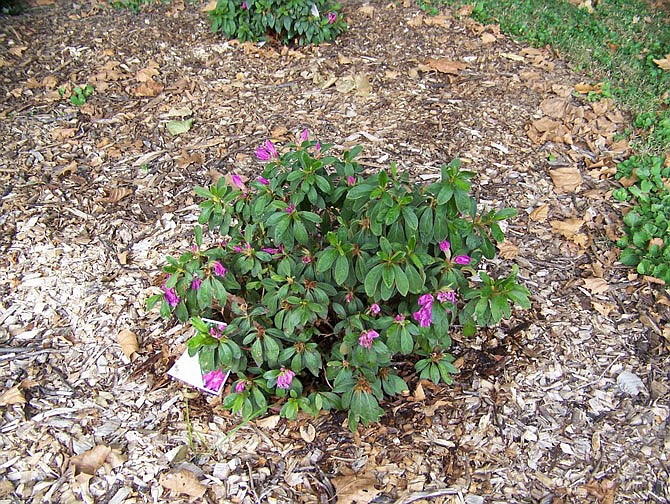Q. I am interested in planting azaleas. What should I do to the soil, and do you have any suggestions on varieties?
A. Azaleas prefer an acid soil, so the best thing to do is get a soil test and adjust as recommended. Azaleas should have a pH less than 6 and closer to 5 if possible. Once the pH has been adjusted, it can be maintained annually with fertilizer sold specifically for azaleas, rhododendrons and hollies. This fertilizer will help the plant grow more and keep the pH suppressed.
Fall is a good time for planting shrubs, but selection may be limited. Re-blooming azaleas are a new development; they have a prolonged late-summer-through-fall blooming phase, which is not as prolific as the spring flush but still nice. I planted several of one cultivar this spring and took a photo of it as an example.
If you can't find plant material this fall, consider digging your holes and amending with sulfur as suggested this fall. Sulfur takes about six months to take full effect, and with the ground pre-worked, planting will be a snap in the spring.
Q. I have an overgrown old-fashioned rose bush. We have to do some construction around it, so I might have to move it. How does one go about this?
A. First, decide how big of clump you want to move. It is better to move a smaller clump of stalks and well intact ball of dirt and roots successfully than to move a larger amount and have it be too heavy or fall apart. You can also use the opportunity to split it up into several if you desire more than one plant (warning: splitting it can cause an intact soil clump to fall apart).
Next, cut it back to about 2 feet tall. The later you can wait to do so, the better - at minimum, the end of October; cut back by mid-December. Once cut back, it would be time to dig it up and relocate. You can do this anytime during the winter as long as the ground isn't frozen, but do it before mid-March. If you move it before winter sets in, it will benefit the plant as some roots can grow during this dormant period.
Digging up the plant can be done by hand, but it is a bit of hard work. A backhoe would be preferable, as its bucket should have the strength to pop out of the ground a ball of dirt and the plant, keeping it intact. Roses will benefit from winter protection, which should be considered given the effort being given to it.
University of Missouri has two good publications on roses that can help round out this discussion: "Roses: Selecting and Planting" and "Roses: Care After Planting." Contact the Extension office if you would like a copy of either.
Q. I have old rotted mulch, and I always get some fresh chips as well. I would like to use it on my vegetable garden. What do you recommend?
A. The rotted mulch can be put down on the vegetable garden this fall and either tilled in or left on the surface to rot through the winter. We generally suggest a layer no deeper than 2 inches. To use fresh chips, those would be best saved for mulching as summer approaches. Generally mid- to late May and June is an ideal time to mulch vegetables, as the plants are getting big enough by then and the weather is getting hotter. Mulch prior to warm weather may hinder growth by suppressing the soil temperature.
Q. I had beautiful Big Boy tomatoes in my container garden this year until a foliar disease hit them. Do I need to get new soil, or is there a way to treat the soil for fungus so it won't happen again?
A. There is no practical way to "disinfect" the soil. If practical, it would be best to use this soil for a different plant next year. The fungus is quite specific to tomato, so it would be safe to grow anything other than tomatoes and peppers. If you want to use the same container and support stake or cage, then first wash and disinfect with a 5 percent household bleach solution.
The Central Missouri Master Gardeners are a volunteer group of 191 members, 122 of whom are Cole County residents, who maintain 11 beautification sites in Cole County, which are nonprofits or public entities. Master Gardeners must complete a basic training program of at least 30 hours of horticultural training, as well as 30 hours of volunteer service. The Missouri Master Gardener program is supported by the University of Missouri Extension.
Have a gardening question of your own? Call 634-2824 or stop by the Cole County Extension Center at 2436 Tanner Bridge Road.

